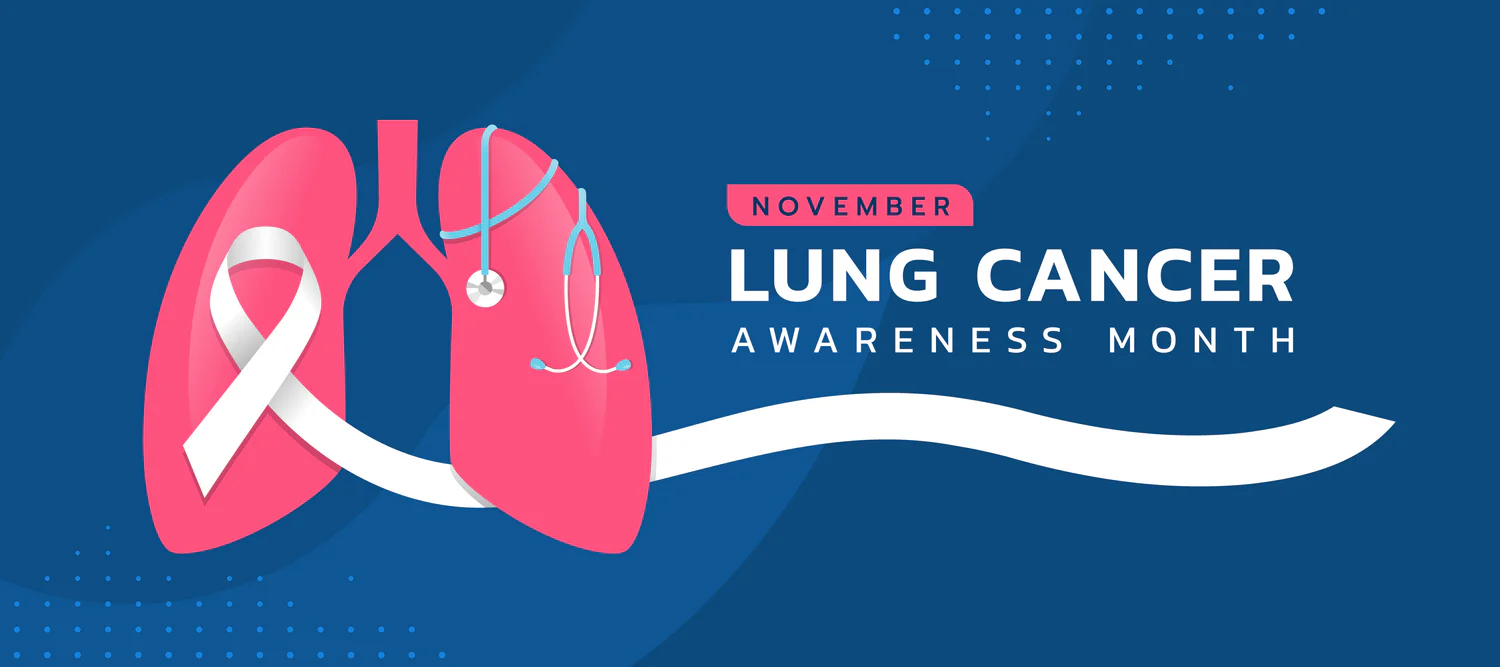Lung Cancer Awareness Relaxation Techniques
November is Lung Cancer Awareness Month, which aims to raise awareness about the most common cancer killer of both men and women. Lung cancer accounts for about 25% of all cancer deaths, causing more deaths than colon, breast, and prostate cancers combined.[1]
Unfortunately, lung cancer is often diagnosed late when it has already spread. The overall 5-year survival rate is only 18%, but it can be as high as 55% when caught early.[1]
Lung cancer is one of the most common and deadly types of cancer. It mainly occurs in older people; two-thirds of people diagnosed are 65 or older. However, anyone can get lung cancer regardless of their age or health status.
This makes it incredibly important to spread awareness about lung cancer risks, symptoms, treatments, and preventative measures. November is Lung Cancer Awareness Month, making it the perfect time to educate yourself and others about this disease.
This article will cover key topics around lung cancer to bring more awareness to this deadly disease, including risk factors, symptoms, diagnosis, treatment options, and what you can do this month to promote lung health.
Increased awareness and education are critical to increasing early detection and survival rates.
Let’s explore some key topics around lung cancer awareness.
Risk Factors
There are several risk factors that can increase a person’s chance of developing lung cancer. The main risk factor is smoking.[2] Other risk factors include:
- Secondhand smoke – Breathing in smoke from other people’s cigarettes, pipes, or cigars can increase lung cancer risk.
- Radon – This naturally occurring gas can accumulate in homes and buildings and is the second leading cause of lung cancer.
- Asbestos – People exposed to asbestos have a higher risk of lung cancer. Asbestos was used as an insulating material in buildings until the 1970s.
- Air pollution – Living in areas with high levels of air pollution appears to increase lung cancer risk slightly.
- Personal or family history – Having a parent, sibling, or child with lung cancer increases risk.
Quitting smoking and avoiding secondhand smoke are the two most important ways to reduce lung cancer risk. Testing homes for radon and removing asbestos products can also help decrease risk.

Symptoms
Lung cancer symptoms don’t usually appear until the disease has advanced. When present, common symptoms include:[3]
- A new cough that won’t go away or gets worse
- Coughing up blood or rust-colored sputum
- Shortness of breath
- Wheezing
- Chest pain, often worsened by deep breathing
- Loss of appetite and weight loss
- Feeling weak or tired
Having these symptoms does not necessarily mean someone has lung cancer. They can also be caused by other lung conditions. Still, it’s important to see a doctor if any of these symptoms arise. Early lung cancer detection leads to better outcomes.
Screening and Diagnosis
There are a few different tests doctors use to screen for and diagnose lung cancer:
- Imaging tests like X-rays, CT scans, PET scans, and MRI scans provide pictures of the lungs that can reveal tumors or other abnormalities.
- Sputum cytology examines mucus coughed up from the lungs for cancer cells.
- A biopsy takes a sample of suspicious lung tissue that is examined by a pathologist for cancer cells.
- Molecular testing on biopsy samples can identify specific genetic mutations associated with some lung cancers. This helps determine treatment.
Low-dose CT screening is recommended for older adults with a history of heavy smoking to detect lung cancer early.[4] If lung cancer is suspected based on screening or symptoms, patients undergo more testing to confirm diagnosis and identify cancer type and stage.
Types
There are two main classifications of lung cancer:
Non-Small Cell Lung Cancer
About 80-85% of lung cancers are non-small cell lung cancer (NSCLC).[5] The three main subtypes of NSCLC are:
- Adenocarcinoma – Begins in mucus-producing cells. This is the most common type of lung cancer. It is usually found in the outer regions of the lung.
- Squamous cell carcinoma – Starts in squamous cells that line the inside of airways. It is linked to smoking.
- Large cell carcinoma – Can occur in any part of the lung. It tends to grow and spread faster than other NSCLC types.
NSCLC is generally treated with surgery, chemotherapy, radiation therapy, targeted drug therapy, or a combination of these.
Small Cell Lung Cancer
Small cell lung cancer (SCLC) makes up about 10-15% of lung cancers.[6] It is strongly associated with smoking. SCLC grows more rapidly than NSCLC and is more likely to metastasize widely throughout the body.
First-line treatment is typically chemotherapy combined with radiation therapy. Surgery is rarely used. Some people may receive targeted therapy. While SCLC is very responsive to initial treatment, it is also more likely to return after treatment.
Stages
Lung cancer staging refers to how far the cancer has spread within the body. Stages range from I (early stage) to IV (most advanced). Some of the key factors considered for staging include[7]:
- Tumor size – How large the primary lung tumor is and whether it has grown into nearby structures.
- Lymph node involvement – Whether the cancer has spread to nearby lymph nodes.
- Metastasis – If the cancer has spread to distant organs and tissues.
Staging helps determine treatment options and outlook. Earlier-stage lung cancers have better survival rates.

Treatment
Treatments for lung cancer include[8]:
- Surgery – If the cancer is localized and fit for surgery, all or part of the tumor and nearby lymph nodes can be removed.
- Chemotherapy – Drugs that destroy cancer cells. Often used as first-line treatment for small cell lung cancer and after surgery for non-small cell lung cancer.
- Radiation – High energy beams used to shrink or eliminate tumors and kill cancer cells. May be done before or after surgery.
- Targeted drug therapy – Drugs that specifically target molecular abnormalities in certain lung cancer cells. Examples are epidermal growth factor receptor (EGFR) inhibitors and anaplastic lymphoma kinase (ALK) inhibitors.
- Immunotherapy – Drugs that help the immune system recognize and attack cancer cells.
- Laser therapy – Using laser energy to shrink small lung tumors.
- Radiofrequency ablation – Using electrical current to heat and eliminate tumors.
If lung cancer is advanced or returns after treatment, the goals may shift to managing symptoms and maximizing quality of life. Palliative care can help with symptom relief.
Prevention
While some risk factors for lung cancer can’t be avoided, certain lifestyle changes can significantly reduce lung cancer risk:[9]
- Quit smoking – Stopping smoking at any age lowers lung cancer risk. The sooner you quit, the more you lower your risk.
- Avoid secondhand smoke – Choose smoke-free environments and ask smokers not to smoke in your home or car.
- Test and mitigate radon – Have your home tested for radon gas and install a mitigation system if levels are high.
- Eat a healthy diet – Eat plenty of fruits and vegetables. Diets high in fruits and vegetables may help protect against lung cancer.
- Get regular physical activity – Being active most days may help lower lung cancer risk.
- Avoid asbestos – Don’t use or work with asbestos, especially in older buildings.
These lung cancer prevention tips also promote overall wellness. Healthy lifestyle choices made today can decrease your risk of lung cancer tomorrow.
Supporting a Loved One with Lung Cancer
If someone you care about is diagnosed with lung cancer, there are many ways you can support them:
- Be there – Make yourself emotionally available and offer non-judgmental support. Listen to their concerns.
- Help manage care – Go with them to appointments, take notes, organize medications, and track symptoms.
- Provide respite – Take over chores or errands to give them time to rest. Offer to cook meals.
- Give encouragement – Remind them to stay hopeful and positive. Motivate them to keep fighting.
- Foster open communication – Ask how they are feeling and what they need. Don’t assume you know.
- Show support – Send cards, care packages, or flowers. Do small acts of kindness.
- Respect boundaries – Don’t force your help if they need space. Offer it graciously.
- Join a support group – Find a lung cancer caregiver support group to connect with others.
- Take care of yourself – Make time for your own self-care so you don’t get burned out.
When someone you love has lung cancer, being compassionate and understanding can make a big difference during their journey. Offer support in any way you can.

Spreading Awareness
During Lung Cancer Awareness Month and beyond, there are many ways to promote lung cancer awareness:
- Wear pearl-colored ribbon – The official color of lung cancer awareness. Wear a pearl ribbon pin year-round.
- Run or walk for lung cancer – Participate in lung cancer fundraiser 5K runs/walks. Volunteer if you can’t participate.
- Buy lung cancer stamps – Ask for lung cancer awareness stamps at the post office. Proceeds support research.
- Donate to lung cancer organizations – Give to groups like the Lung Cancer Research Foundation and Lungevity Foundation.
- Host an awareness event – Organize a community educational forum. Share your story.
- Advocate for change – Support anti-smoking and radon testing legislation. Push for lung cancer screening policies.
- Share on social media – Post facts, stories, and infographics using hashtags like #LungCancerAwarenessMonth.
- Educate loved ones – Talk to friends and family about the importance of lung cancer screening and prevention. Share this post!
Raising awareness makes a real impact. The more we spread the word, the more lung cancer cases can be caught early and treated successfully. Get out and raise some awareness today!
Valuable Lung Cancer Resources
- American Lung Association – Offers information on lung cancer screening, diagnosis, treatment, and support programs. They have a Lung HelpLine at 1-800-LUNGUSA. Website: www.lung.org
- Lung Cancer Research Foundation – Funds innovative research and provides educational resources. You can speak to a nurse navigator at 646-844-0758. Website: www.lcrf.org
- Lungevity Foundation – Provides peer-to-peer support for lung cancer patients/caregivers. They offer educational materials at www.lungevity.org.
- CancerCare – Provides counseling, support groups, education, and financial assistance. Reach them at 1-800-813-HOPE. Website: www.cancercare.org.
- Cancer Support Community – Offers support services and education for cancer patients/families. Call their helpline at 888-793-9355. Website:
www.cancersupportcommunity.org. - American Cancer Society – Call their 24/7 helpline at 1-800-227-2345 or visit www.cancer.org for lung cancer information and local resources.
- Lung Cancer Alliance – Advocates for patients, raises awareness, and provides community. Phone: 1-800-298-2436. Website: https://lungcanceralliance.org/
Top Online Lung Cancer Resources
- Lungcancer.org – Run by the Lung Cancer Research Foundation, this site has detailed information on lung cancer types, staging, treatments, clinical trials, and news. It also has an online community forum.
- Cancer.net – The American Society of Clinical Oncology’s patient site with comprehensive lung cancer info on risk factors, diagnosis, treatments, coping, research, and more.
- LungCancer.net – Patient-oriented site by Oncimmune with sections covering lung cancer 101, living with lung cancer, latest news, clinical trials, and treatment options.
- CancerCare.org – This nonprofit offers telephone and online support groups, counseling, education, and financial assistance for those affected by lung cancer.
- LungCancerAlliance.org – Provides lung cancer treatment information, an online community, and a national lung cancer helpline at 1-800-298-2436.
- CancerSupportCommunity.org – Offers online lung cancer support groups, counseling services, educational workshops, and more.
- LUNGevity.org – Dedicated to lung cancer research and support, this site has treatment info, virtual events, newsletters, and an online community.
- Inspire.com – Connect with others affected by lung cancer on this social health network with over 1 million members.
- SmartPatients.com – Evidence-based lung cancer info and the ability to connect anonymously with other patients in online communities.
Conclusion
Raising awareness about lung cancer risks, emphasizing early detection, and providing support can save lives. Know the symptoms and avoid tobacco smoke and carcinogens. Consider regular screenings if at high risk.
Seek evaluation for persistent respiratory symptoms. Continue to educate, support those diagnosed, and spread awareness. Lung cancer takes too many lives each year. Increase awareness, advocate for early screening, and support those diagnosed. Together, we can reduce lung cancer incidence and improve outcomes.
Sources:
[1] Dela Cruz, Charles S et al. “Lung cancer: epidemiology, etiology, and prevention.” Clinics in chest medicine vol. 32,4 (2011): 605-44. doi:10.1016/j.ccm.2011.09.001
[2] de Groot, Patricia, and Reginald F Munden. “Lung cancer epidemiology, risk factors, and prevention.” Radiologic clinics of North America vol. 50,5 (2012): 863-76. doi:10.1016/j.rcl.2012.06.006
[3] Bradley, Stephen H et al. “Recognising Lung Cancer in Primary Care.” Advances in therapy vol. 36,1 (2019): 19-30. doi:10.1007/s12325-018-0843-5
[4] Wood, Douglas E et al. “Lung cancer screening.” Journal of the National Comprehensive Cancer Network : JNCCN vol. 10,2 (2012): 240-65. doi:10.6004/jnccn.2012.0022
[5] Clark, Shane B. and Saud Alsubait. “Non–Small Cell Lung Cancer.” StatPearls, StatPearls Publishing, 5 September 2022.
[6] Rudin, Charles M et al. “Small-cell lung cancer.” Nature reviews. Disease primers vol. 7,1 3. 14 Jan. 2021, doi:10.1038/s41572-020-00235-0
[7] Chheang, Sophie, and Kathleen Brown. “Lung cancer staging: clinical and radiologic perspectives.” Seminars in interventional radiology vol. 30,2 (2013): 99-113. doi:10.1055/s-0033-1342950
[8] Lemjabbar-Alaoui, Hassan et al. “Lung cancer: Biology and treatment options.” Biochimica et biophysica acta vol. 1856,2 (2015): 189-210. doi:10.1016/j.bbcan.2015.08.002
[9] Jassem, Jacek. “Lung cancer: a preventable disease.” Translational lung cancer research vol. 8,Suppl 1 (2019): S1-S2. doi:10.21037/tlcr.2019.04.13







